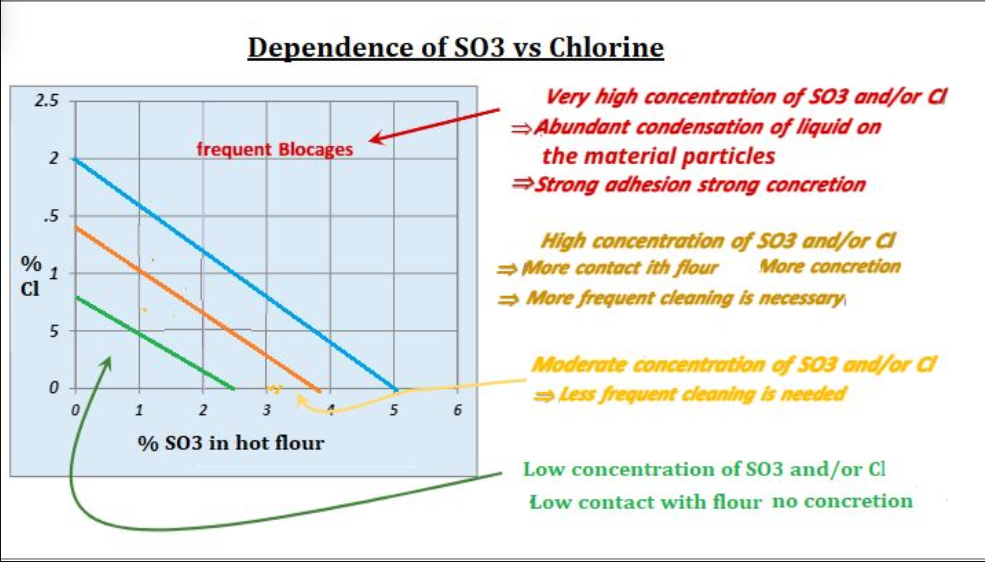Contents
Understanding the Dependence of SO3 vs Chlorine in Cement Production

TO Download this post and all the books and excel sheets and my personal notes and presentations I collected about cement industry in the last 30 years click the below paypal link
In the cement industry, the interaction between sulfur trioxide (SO3) and chlorine (Cl) plays a critical role in the efficiency of production processes. The graph you’ve provided highlights the relationship between these two compounds, illustrating how their concentrations impact the material handling and operational efficiency in cement kilns.
The Role of SO3 and Chlorine in Cement Production
Sulfur trioxide (SO3) is a common byproduct in cement manufacturing, primarily from the combustion of sulfur-bearing fuels. Chlorine (Cl) can be introduced into the process through raw materials, alternative fuels, or even through secondary contamination. Both compounds can have significant impacts on kiln operations, influencing everything from the formation of buildups to the efficiency of clinker production.
Interpreting the Graph: SO3 vs Chlorine
The graph shows a direct correlation between the percentage of SO3 in hot flour and the percentage of chlorine present. The chart is divided into zones that indicate the severity of potential operational issues:
- Zone of Frequent Blockages (High SO3 and Cl Concentration)
- Description: In this zone, both SO3 and Cl are present in very high concentrations. This leads to abundant condensation of liquid on material particles, which in turn causes strong adhesion and the formation of concretion.
- Operational Impact: The strong concretion and adhesion increase the likelihood of blockages within the kiln, leading to frequent disruptions. This necessitates more regular shutdowns for cleaning, which can significantly reduce the overall efficiency of the production process.
- Mitigation Strategies: To minimize blockages, it’s crucial to monitor and control the levels of SO3 and Cl in the kiln. Adjusting fuel types, optimizing raw material composition, and improving the combustion process can help reduce these concentrations.
- High SO3 and Cl Concentration
- Description: In this zone, the concentration of SO3 and Cl is still high, leading to more frequent contact with the flour. This results in more severe concretion and increases the need for frequent cleaning.
- Operational Impact: The buildup of deposits due to high SO3 and Cl levels can obstruct material flow and cause operational inefficiencies. Over time, these buildups can harden, making them difficult to remove and potentially causing damage to kiln linings.
- Mitigation Strategies: Regular monitoring and targeted cleaning schedules are essential in this zone. Additionally, using alternative raw materials with lower Cl content or employing additives that inhibit buildup can be beneficial.
- Moderate SO3 and Cl Concentration
- Description: At moderate concentrations, the effects of SO3 and Cl are less severe, leading to fewer blockages and less frequent cleaning requirements.
- Operational Impact: While some buildup may still occur, it is typically easier to manage and does not necessitate constant attention. The kiln can operate more smoothly, with fewer interruptions.
- Mitigation Strategies: Continuous process optimization, including the adjustment of flame temperature and careful control of material feed rates, can help maintain SO3 and Cl at moderate levels, thereby reducing operational risks.
- Low SO3 and Cl Concentration
- Description: In this zone, both SO3 and Cl are present in low concentrations, resulting in minimal contact with the flour and no significant concretion issues.
- Operational Impact: This is the ideal operational zone, where the risk of blockages is minimized, and the kiln can operate at peak efficiency with minimal interruptions.
- Mitigation Strategies: To maintain low concentrations of SO3 and Cl, it’s important to optimize fuel choices and raw material inputs consistently. This can involve using higher-quality fuels with lower sulfur content or employing advanced filtration systems to capture and neutralize these compounds before they enter the kiln.
Practical Applications and Recommendations
For cement plant operators, understanding the relationship between SO3 and chlorine is vital for maintaining efficient and continuous production. The key is to strike a balance between the concentrations of these compounds to prevent the negative impacts associated with high levels, such as blockages and excessive buildups.
Operational Recommendations:
- Regular Monitoring: Implement continuous monitoring systems for SO3 and Cl levels in the kiln atmosphere and raw materials. This will allow for real-time adjustments to keep concentrations within manageable limits.
- Process Optimization: Utilize advanced kiln control systems that can adjust operational parameters dynamically to respond to fluctuations in SO3 and Cl levels.
- Material Selection: Where possible, select raw materials and fuels that are lower in sulfur and chlorine. Additionally, consider using alternative fuels that produce less SO3 as part of the combustion process.
- Preventative Maintenance: Develop and adhere to a strict cleaning schedule, particularly in zones identified as high risk for blockages. This will help to minimize the buildup of material and reduce the likelihood of operational disruptions.
Conclusion
The dependence of SO3 versus chlorine in the cement production process is a critical factor that influences the overall efficiency of kiln operations. By understanding and controlling these variables, cement plants can optimize their processes, reduce the risk of blockages, and maintain a more consistent and efficient production cycle.
Sources and References
- Cement Kiln Process Overview – Cement Technology
- Impact of SO3 and Cl on Kiln Operation – Kiln Chemistry
- Preventative Maintenance in Cement Kilns – Cement Engineering
- Advanced Kiln Control Systems – Industrial Control Systems
These references provide additional context and detailed information on the complex interactions between SO3, Cl, and the operational efficiency of cement kilns. By following the insights and strategies outlined, plant operators can significantly improve their processes, leading to more sustainable and cost-effective production.
TO Download this post and all the books and excel sheets and my personal notes and presentations I collected about cement industry in the last 30 years click the below paypal link
